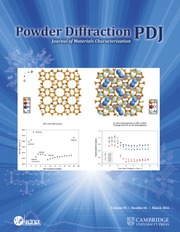No CrossRef data available.
Article contents
In situ monitoring of cristobalite within a glass matrix via high-temperature X-ray Diffraction (XRD)
Published online by Cambridge University Press: 19 June 2025
Abstract
We report the lattice parameters and cell volume for cristobalite powder added at 35 wt% to Ba-Al-Silicate glass (CGI930) as reflowed bulk glass bars where the embedded cristobalite phase is constrained within the glass matrix. Analysis confirms that the room temperature lattice parameters and cell volume obtained for the bulk glass–ceramic are larger compared with single-phase cristobalite powders. The increased volume of the cristobalite phase in a glass matrix is driven by tensile stresses developed at the interface between the cristobalite and matrix glass phase, and this stress impacts the phase transition temperature and thermal hysteresis of the cristobalite phase. In situ high-temperature measurements confirm that the tetragonal to cubic α–β phase transformation of the cristobalite phase within the glass matrix is ~195 °C with complete suppression of hysteresis behavior. In contrast, bulk glass–ceramic material ground to a powder form displays the expected thermal hysteresis behavior and more comparable phase transition temperatures of 245 °C on heating and 220 °C on cooling. Isothermal holds at varying temperatures above or near the α–β phase transition suggest that the cristobalite phase does not undergo significant relaxation within the matrix phase to reduce accumulated stress imposed by the constraining matrix glassy phase.
Information
- Type
- Proceedings Paper
- Information
- Copyright
- © The Author(s), 2025. Published by Cambridge University Press on behalf of International Centre for Diffraction Data


